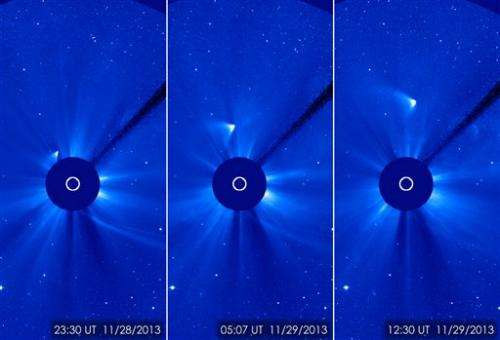Hubble Telescope best shot at learning comet fate (Update)

NASA said Monday that the Hubble Space Telescope is the best bet for figuring out whether Comet ISON disintegrated during its brush with the sun last week.
A pair of solar observatories saw something emerge from around the sun following ISON's close approach on Thanksgiving Day. But scientists don't know whether the spot of light was merely the comet's shattered remains or what's left of its icy nucleus. Either way, by now, they say it may be just dust.
Over the coming week or two, scientists will keep a lookout for any brightening, which could indicate what, if anything is left. Hubble should put the matter to rest in mid-December, when the comet's remains are far enough from the sun for safe viewing.
As for us earthlings, there appears to be little chance of spotting what's left of the comet with the naked eye. Whatever is left will pass closest to Earth on Dec. 26; it will keep a safe 40 million miles (64 million kilometers) away.
ISON was making its first visit to the inner solar system, after traveling from the Oort cloud on the fringes of the solar system, home to countless icy bodies, most notably the frozen balls of dust and gas in orbit around the sun known as comets
It was discovered by Russian astronomers last year and, early on, was predicted to become the comet of the century because of its brightness. Indeed, ISON would have wowed observers if it had survived the sun's fury.
NASA turned all its space eyes on the sun-grazing comet throughout the year, watching as ISON advanced ever closer. Even scientists were left wondering whether the comet would survive its encounter with the sun from just 730,000 miles (1.17 million kilometers) out.
In an online blog, the Naval Research Laboratory's Karl Battams paid tribute Monday to ISON and suggested that donations be made to astronomy clubs, observatories or charities supporting science and math education for children.
"Never one to follow convention, ISON lived a dynamic and unpredictable life, alternating between periods of quiet reflection and violent outburst," Battams, an astrophysicist, wrote. "Comet ISON leaves behind an unprecedented legacy for astronomers, and the eternal gratitude of an enthralled global audience."
© 2013 The Associated Press. All rights reserved.




















